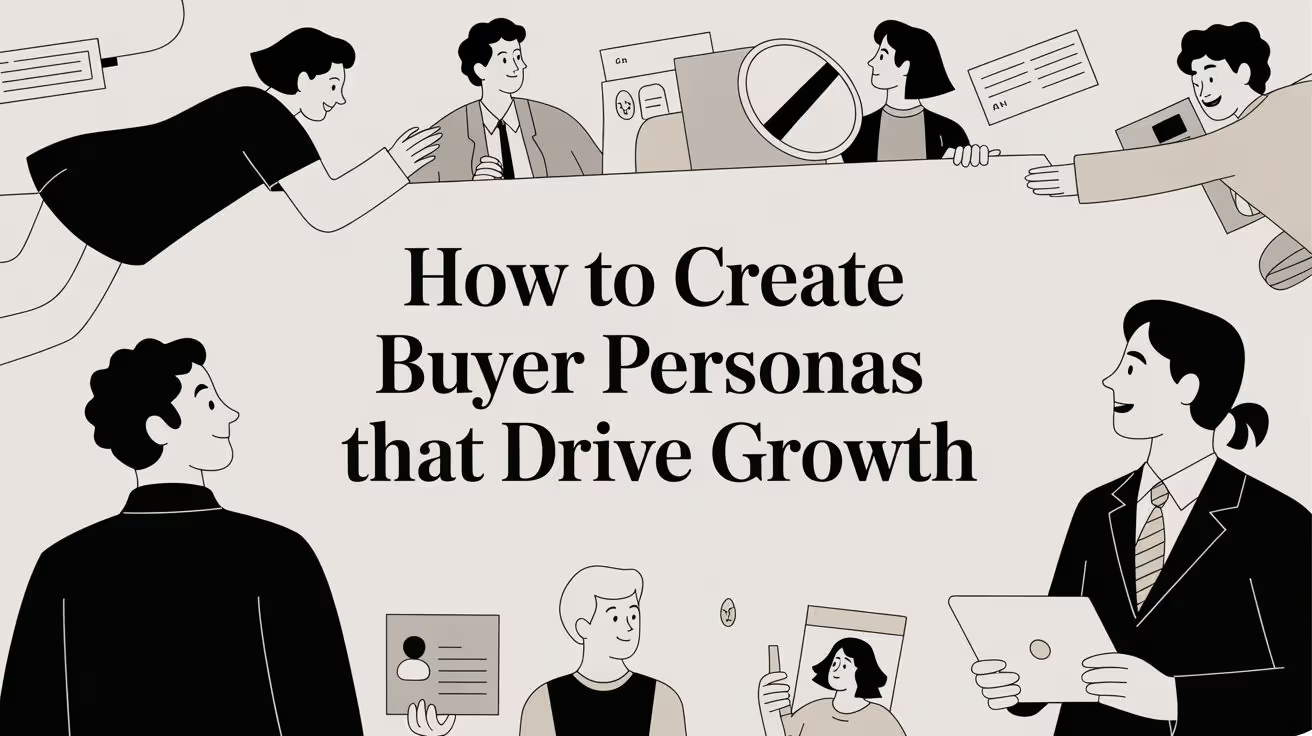Effective marketing starts with knowing who you're talking to. Creating buyer personas isn't about guesswork; it's about building research-backed profiles of your ideal customers. By digging into real data to understand their goals, challenges, and motivations, you can craft a strategy that genuinely resonates and drives results.
Moving Beyond Guesswork to Modern Buyer Personas

Let's be honest: many buyer personas are just glorified guesses collecting dust on a server. They are often built on broad assumptions instead of hard evidence, resulting in generic profiles with little strategic value.
Modern, high-impact personas are a different beast entirely. They're no longer a "nice-to-have" exercise but the core of a profitable, customer-focused strategy. Think of a powerful persona as a living document—a detailed narrative built on actual customer data, candid interviews, and behavioral analytics.
The Shift from Assumptions to Actionable Insights
So, what separates a persona that drives results from one that’s useless? A commitment to grounding every detail in reality. You aren't inventing a character from scratch; you're uncovering one that already exists within your customer base. This process requires a mental shift, moving from creative storytelling to something more like investigative journalism.
This isn't just about better marketing—it’s about better business. Companies that truly understand their customers consistently outperform their competitors. The proof is in the numbers.
For instance, Deloitte found that customer-centric organizations—which rely on deep customer understanding—are 60% more profitable than their less-focused counterparts. And when personas inform marketing tactics, the results speak for themselves. Personalized email campaigns using personas see a 14% jump in click-through rates and generate 18 times more revenue than generic broadcast emails.
A well-crafted buyer persona isn’t just a document; it’s a strategic lens. It clarifies who you're talking to, what they care about, and how you can solve their specific problems.
Why Data-Driven Personas Matter
When you understand the "who" behind the clicks and conversions, your entire approach transforms. Building buyer personas based on solid research unlocks several key advantages across your business.
- A Smarter Content Strategy: You can stop guessing and start creating blog posts, videos, and social content that directly address the pain points and questions of your ideal customers.
- Targeted Product Development: Your product teams gain a clear picture of who they're building for. This helps them prioritize features and develop solutions that solve real-world problems for the people who will actually use them.
- More Effective Sales Enablement: Your sales team can enter conversations armed with insight. They can tailor their pitches and demos to resonate with a prospect's specific goals and challenges, leading to more meaningful discussions.
Ultimately, this process is about achieving empathy at scale. By investing time to deeply understand your audience, you build a foundation for more effective communication and stronger, more profitable relationships. You can dive deeper into this subject by checking out our guide on data-driven marketing solutions.
Key Components of a High-Impact Buyer Persona
To ensure your personas are strategic assets rather than simple descriptions, they need to include specific, actionable components. Each piece of information should reveal something that helps your team make better decisions.
This table breaks down the essential elements that give a buyer persona its strategic power.
By focusing on these key areas, you ensure your personas provide genuine insight that can be used across marketing, sales, and product development to drive real business results.
Gathering the Raw Data for Your Personas
Great personas aren't built on assumptions or what you think you know about your customers. They are built on data. This is where the real work begins—collecting the raw information that will eventually paint a complete, authentic picture of your ideal customer.
It's a two-part mission. First, you need to understand what your customers do. This comes from quantitative data: the clicks, page views, and purchase histories. Second, you need to understand what they think. This is the qualitative side of the equation—their frustrations, goals, and stories. Get both right, and you're golden.
Tapping into Your Quantitative Data Sources
Quantitative data tells you the "what." It’s the objective, measurable proof of customer behavior, and your existing systems are sitting on a goldmine of it. This is where you uncover patterns you might never have guessed existed.
Start digging in these key places:
- Google Analytics: Your website analytics provide a window into your audience's digital body language. How do people find you? Where do they go once they arrive? Look at traffic sources, the most popular pages, and session duration. If most visitors come from organic search and immediately click your pricing page, that tells a story.
- CRM Database: Your Customer Relationship Management (CRM) system is a treasure trove. Dive into purchase history, average deal size, and sales cycle length. You might find your most profitable clients share the same job title or come from a particular industry.
- Social Media Analytics: Platforms like LinkedIn, X (formerly Twitter), and Facebook offer incredible demographic and engagement data. Check the age, location, and professional backgrounds of your followers. More importantly, see which posts generate conversation. That's a direct signal of what your audience cares about.
A modern, data-driven approach leans heavily on these tools. When you track demographics and user behavior, you start to see trends. For instance, you might discover that 70% of customers visit three specific blog posts before contacting sales. That’s not an assumption; it's a fact you can build on. You can learn more about how to use this data by reading up on data-driven personas on magnolia-cms.com.
Uncovering Qualitative Insights Through Human Interaction
Numbers tell you what is happening, but they rarely tell you why. That's where qualitative research comes in. This is how you uncover the motivations, emotions, and real-world context behind the data. It's what makes a persona feel less like a spreadsheet and more like a real person.
The best way to get this information is simple: talk to people.
The most powerful insights often come from a simple conversation. A single customer interview can reveal a pain point or motivation that you’d never find in a spreadsheet.
Here’s how to get those crucial stories:
- Conduct Customer Interviews: This is the cornerstone of good persona research. Set up 20-30 minute calls with a mix of your customers—your champions, your newest clients, and even a few who left for a competitor. Ask open-ended questions about their challenges and what their world looked like before they found a solution.
- Talk to Your Sales Team: Your sales reps are on the front lines every day. They know the objections, the frequently asked questions, and the "aha!" moments prospects experience. Ask them what triggers someone to start looking for a product like yours.
- Analyze Support Tickets: Your customer support team is a direct pipeline into user frustrations. Go through recent support tickets and chat logs. Look for recurring problems or common areas of confusion. These are real, documented pain points.
- Deploy Simple Surveys: Use short, targeted surveys to get feedback quickly. An exit-intent survey asking why someone is leaving your site can be incredibly revealing. A quick post-purchase survey can ask what ultimately sealed the deal. Keep them brief to respect users' time and improve response rates.
Blending the numbers with the stories is what makes this process work. The analytics give you the skeleton, but the interviews and feedback provide the heart and soul. Properly integrating this information is key to building a persona that helps your team. If you want to dive deeper, our guide on customer data integration solutions is a great next step. This balanced approach is how you get from a flat profile to a rich, authentic portrait of your customer.
Finding Patterns and Defining Your Core Segments
You’ve gathered the data and are now likely looking at a mountain of interview transcripts, survey results, and analytics reports. This raw information is pure gold, but its real value is unlocked when you start connecting the dots. The mission now is to sift through the noise and find the meaningful patterns that will define your core customer segments.
Think of yourself as a detective. You're hunting for recurring themes, shared frustrations, and common goals. Your qualitative data is the story, and your quantitative data is the hard evidence that proves the story is true.
From Raw Data to Cohesive Themes
I recommend starting with your qualitative research—those interviews and open-ended survey questions. As you comb through the transcripts and responses, zoom out and look for the bigger concepts that keep appearing.
For instance, maybe five out of ten people you interviewed mentioned feeling "overwhelmed by manual data entry" or "frustrated with a lack of integration." Those aren't just one-off comments; they're the seeds of a core pain point for a potential persona.
Keep an eye out for:
- Common Language: What specific words or phrases do your customers use to describe their problems or goals?
- Recurring Challenges: Are multiple people bringing up the same obstacles in their day-to-day work?
- Shared Goals: Is there a common thread in what they’re all trying to accomplish professionally?
- Motivation Triggers: What event or situation pushes someone to look for a solution like yours?
As you spot these themes, start grouping them. This is how you move from a pile of individual data points to a structured set of insights. You're essentially building the skeleton of your personas from real human experiences.
Validating Insights with Hard Data
Once you have a good feel for the qualitative themes, it’s time to bring in your quantitative data to see if the numbers back them up. This step is critical. It ensures your personas aren't just built on a few compelling stories but represent a larger, measurable chunk of your audience.
So, if your interviews pointed to "inefficient reporting" as a major pain point, dig into your website analytics. Is your blog post titled "5 Ways to Automate Your Monthly Reports" one of your top-performing pages? That connection validates that the pain point isn't just anecdotal—it's real and widespread.
A persona built on qualitative insights alone is a hypothesis. A persona validated with quantitative data is a strategic tool. It confirms that the problems you've heard are not just stories but measurable trends.
It’s all about layering your information. The "why" from your interviews gives crucial context to the "what" from your analytics. When you combine them, you get a robust, defensible foundation for how to create buyer personas that actually reflect your audience.
This infographic is a great visual for how raw data points can be clustered into distinct customer segments.

As you can see, analyzing behaviors and motivations allows you to clearly identify different groups that need to be spoken to in completely different ways.
Defining Your Core Segments
At this point, you should see distinct groups emerging from your data. These are your segments—groups of people who share similar goals, challenges, and behaviors. The number of personas you need depends on your business, but most companies find a sweet spot starting with three to five core segments.
Let's walk through an example. Imagine a B2B software company that sells a project management tool. After analyzing their research, they might identify two very different segments:
- The High-Level Strategist: This group is made up of executives and department heads. Their main goal is visibility and ROI. They care less about granular features and are focused on high-level reporting and budget alignment. Their trigger is often a missed company deadline or a new directive to improve departmental efficiency.
- The In-the-Trenches Manager: This segment includes team leads and project managers. Their world revolves around team productivity and workflow efficiency. They focus on features, integrations, and how the tool will fit into their team's existing process. Their trigger is usually a specific project bottleneck or team complaints about current tools.
These two groups might buy the same product, but their motivations and decision-making criteria are worlds apart. Recognizing this difference is the entire point of segmentation. For a deeper look, these proven customer segmentation strategies offer a great framework for refining your approach. Nailing this step ensures that when you finally build your personas, they represent real, distinct groups that need their own unique marketing and sales playbook.
All your research is done. You've dug through the analytics, held eye-opening interviews, and pinned down the key segments that make up your audience. Now for the fun part: learning how to create buyer personas by turning all those spreadsheets and notes into a real, human story your whole team can get behind.
This is where you breathe life into the data. The objective is to build a profile so vivid that your team feels like they could pull up a chair for them in a meeting. It's less about listing facts and more about crafting a narrative that makes the numbers feel personal.
Structuring a Compelling Persona Profile
A great persona profile isn't just a name on a stock photo. It’s a well-organized document that tells a story while delivering actionable insights. To make it work, you need to weave a narrative around the data points you've uncovered.
A simple trick is to give your persona an alliterative name, like 'Strategic Sarah,' which makes them easier to remember and reference. Next, find a stock photo that feels like the person you've been researching—it helps solidify the persona as a real individual in everyone's mind.
With the basics down, it’s time to flesh out their professional life:
- Role and Responsibilities: Don't just stop at a job title. What does 'Strategic Sarah' really do all day? Get specific about her main duties, the KPIs she's measured against, and who she reports to.
- A Day in the Life: Write a brief narrative describing a typical workday. This is a surprisingly powerful way to build empathy and put her challenges into a real-world context.
- Primary Goals: What does success look like for her? Based on your interviews, define her top professional goals. For Sarah, it might be, "Successfully lead the company's digital transformation initiative to increase operational efficiency by 15%."
- Biggest Challenges: Here's where your solution fits in. What's stopping her from reaching those goals? A key challenge for Sarah is, "Overcoming internal resistance to change and navigating the limitations of legacy software systems."
When you structure the profile this way, you end up with a document that’s both descriptive and strategic. It gives your team a crystal-clear picture of who they’re trying to serve.
Making Your Persona Feel Real
A dry list of goals and challenges won't stick. To make your persona memorable and useful, you must ground it in authentic, human details. One of the best ways to do this is by using direct quotes from your customer interviews.
Pulling a direct quote like, "I spend half my Monday just trying to get our different systems to talk to each other," is far more impactful than simply listing "data integration issues" as a pain point.
These real-world quotes are a constant reminder that your persona represents actual people with real frustrations. It’s a small detail that makes a huge difference in how your team uses the document.
You can make the persona even more real by identifying their "watering holes"—the specific blogs, industry publications, conferences, and social media influencers they follow. This is pure gold for your marketing team; it tells them exactly where they need to be to get Sarah's attention.
Plenty of online tools can also help you visualize and organize this information. Persona generators can help you structure your findings into a clean, professional, and shareable format.

This screenshot shows how a simple tool walks you through adding key details like job titles, goals, and challenges, outputting a polished persona card at the end.
Ultimately, a well-defined persona is the foundation of a strong brand identity. It ensures that every piece of communication, from a website headline to a sales email, is tuned to the right frequency. To dig deeper into how personas shape brand perception, check out our guide on branding and visibility. This ensures your message doesn't just reach the right people—it resonates with them on a level that creates a lasting impression.
Putting Your Personas into Action
Let's be honest: creating buyer personas is an eye-opening process. But if they just end up sitting in a shared drive, they’re not doing much for you. Their real power is unleashed when they move from a document into your day-to-day operations.
A well-built persona should become the lens through which every team views their work. When used actively, they create a massive shift in how your business communicates. Marketers can stop guessing and start writing blog posts and ad copy that hit home. Sales teams can enter conversations already knowing a prospect's likely objections and goals, turning a hard sell into a helpful consultation.
Aligning Strategy Across Departments
The most successful companies don't just create personas; they weave them into the fabric of the organization. This ensures everyone is working from the same customer-centric playbook. It's the best way to eliminate the disconnect that often arises between marketing, sales, and product development.
Imagine your product team has a clear persona like 'Technical Tom' in front of them. Instead of chasing the shiniest new tech trend, they can prioritize features that solve his real-world needs for efficiency and slick integrations. This is how you build a product people actually want to use.
When every department is aligned, you create a customer experience that’s consistent and compelling at every touchpoint. The language in your marketing emails will echo the solutions your sales team discusses, which will perfectly match the features your product team builds.
A Fintech Case Study in Persona-Driven Success
This isn't just theory. Look at the real-world example of a fintech banking app that used behavioral economics to build its buyer personas. A fascinating case study on their approach showed these persona-driven strategies are forecasted to boost the client's revenue by 29% and increase new customer acquisition by 15%.
The secret? They took the time to understand the nuances of different customer segments and tailored the digital experience to match. You can dig into more of their persona-driven strategies over at simon-kucher.com.
Let's break this down with another scenario. Say a fintech app identifies a key persona: 'Budget-Conscious Brianna.' She's a tech-savvy millennial professional who feels overwhelmed by complicated financial products. Her main goal is saving for a down payment, but she's frustrated by confusing jargon and hidden fees.
Armed with this insight, the company could take several specific actions:
- Product Redesign: Greenlight a new feature that offers simple, visual savings goals and automates micro-investing from her checking account.
- Content Marketing: Launch a blog series called "Decoding Your Finances," breaking down complex topics like mortgages and investments into simple, easy-to-read articles.
- Email Marketing: Segment their email list to send Brianna tips on budget-friendly lifestyle hacks and updates on her savings goals, not generic product announcements.
This strategic shift, driven entirely by understanding one persona, directly solves her problems and helps her reach her goals. That's how you build fierce loyalty.
A buyer persona is only as valuable as the actions it inspires. If it isn't influencing your content, shaping your sales conversations, and guiding your product roadmap, it isn't working hard enough.
Activating Personas in Your Marketing Funnel
To make your personas truly work for you, you have to map out their journey. Think about how someone like 'Budget-Conscious Brianna' would move through your marketing and sales process.
At the top of the funnel, she might be Googling things like "best apps for saving money." Your persona-optimized blog content should be right there, waiting for her.
Once she becomes a lead, your follow-up needs to be just as targeted. Instead of a generic "Welcome!" email, send her a link to a guide on "5 Simple Steps to Start Saving for Your First Home." This personalized touch is at the heart of effective lead nurturing.
To see how this works in practice, check out our detailed guide on lead nurturing automation. It's all about delivering the right message at the right time, guiding your ideal customer toward a solution that genuinely helps them.
Still Have Questions About Buyer Personas?
Even with a clear plan, a few questions always seem to pop up when you're getting started with buyer personas. That's perfectly normal. Let's walk through some of the most common ones—getting these answers straight can save you from heading down the wrong path and make sure your final personas are actually useful.
How Many Buyer Personas Should We Create?
There’s no magic number, but the golden rule here is quality over quantity.
Most businesses find a sweet spot with three to five core personas. These should represent your most important and distinct customer segments. Think about who drives the most revenue or the specific audience you're trying to attract.
Creating a dozen personas right out of the gate will dilute your focus. It’s a common mistake. If you find two of your draft personas have nearly identical goals and challenges, don't be afraid to merge them into a single, more powerful profile. The goal is to have clearly defined groups that genuinely need different marketing messages or sales tactics. You can always add more nuanced personas later as you grow.
What’s the Real Difference Between a Buyer Persona and a Target Audience?
This is a big one, and the distinction is crucial. It’s the difference between a blurry photo and a high-definition portrait.
Think of it like this: a target audience is broad and demographic-based, while a buyer persona is specific and deeply human.
- Target Audience: A general description of a group. For example, "Marketing managers, aged 30-45, working at mid-sized tech companies in North America." It tells you what they are.
- Buyer Persona: A semi-fictional story about a single person from that audience. For example, "Marketing Manager Molly, 36, is struggling to prove the ROI of her campaigns to her CFO. She’s motivated by data-driven results and spends her mornings reading industry blogs to find new analytics tools." This tells you who she is.
A target audience gives you a wide net to cast, but a buyer persona gives you a real person to talk to. That shift from a faceless group to an individual is what makes your marketing feel personal and far more effective.
A target audience describes a demographic slice of the market. A buyer persona brings an individual from that slice to life, complete with motivations, daily frustrations, and personal goals. One is a statistic; the other is a story.
How Often Should We Update Our Buyer Personas?
Buyer personas are not "set it and forget it" documents. Markets shift, new tech emerges, and your customers' priorities and behaviors change. Treat your personas as living documents that need a regular tune-up to stay relevant.
As a best practice, schedule a review of your personas at least once a year.
That said, some events should trigger an immediate update, no matter when your annual review is scheduled.
Consider a significant revision when you:
- Launch a major new product or service.
- Move into a new industry or geographic market.
- Notice a big shift in customer feedback or analytics trends.
- Go through a rebrand or change your company's core value proposition.
Keeping your personas fresh isn’t just a nice-to-have; it’s directly tied to performance. Research shows that more than 60% of companies that updated their personas within the last six months were more likely to exceed their revenue goals. This demonstrates how important it is to treat persona development as an ongoing process, not a one-time project.
At Twelverays, we specialize in moving businesses beyond guesswork. We build data-driven strategies grounded in a deep understanding of your ideal customer, ensuring your marketing efforts resonate, convert, and drive measurable growth. Learn how we can help you connect with your audience by visiting https://twelverays.agency.





